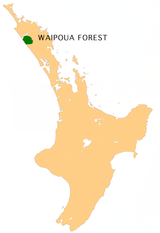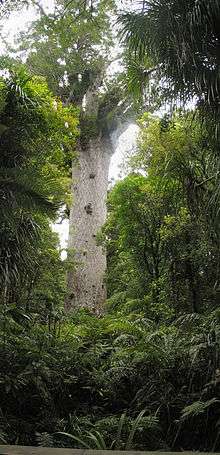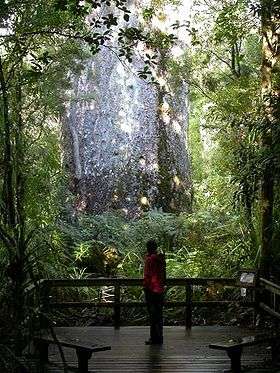Waipoua Forest


Waipoua Forest preserves some of the best examples of kauri forest remaining in New Zealand. It is notable for having two of the largest living kauri trees, Tane Mahuta and Te Matua Ngahere. The forest was declared a sanctuary in 1952. A community based volunteer organisation, the Waipoua Forest Trust, helps maintain the forest.
Location
The forest, on the west coast of the Northland Region, is associated with the neighbouring Waima and Mataraua Forests. The forest sanctuary is bordered to the south by the 350 hectares (860 acres) Professor W.R McGregor Reserve, named after W. R. McGregor (1894–1977).[1] In the 1940s, McGregor successfully campaigned to end logging of the forest and to have it declared a sanctuary, a status it achieved in 1952.[2][3]
Ecology
The Waipoua, Warawara and Puketi forests together contain about three quarters of New Zealand's remaining mature kauri trees. The Waipoua forest holds the largest remaining stand of these trees.[4] It contains Te Matua Ngahere, a notable kauri tree that is the largest in New Zealand by girth and the second largest by volume, and is estimated to be from 2,000 to 3,000 years old.[5] The trees are threatened by the fungus Phytophthora taxon Agathis.[6][7] The Waipoua Forest Trust has called for urgent action by the government to find a cure for the problem.[8] The forest has the largest population of North Island brown kiwi in Northland. Populations of the endangered North Island kōkako can be found in the high plateau country.
A forest fire threatened Waipoua Forest when it broke out on 1 February 2007 after someone had been cooking mussels on an open fire at a nearby beach. The fire burnt pine plantation adjoining the native forest, but destroyed ecologically significant wetland vegetation, and came within 3 kilometres (1.9 mi) of the iconic Tāne Mahuta. The blaze was fought by local fire fighters and conservation volunteers, who managed to stop its spread using helicopters and fire breaks. Millions of dollars of pine, and many endangered birds, were lost, including an estimated 20 North Island brown kiwi. In all the fire claimed over 2 square kilometres (0.77 sq mi) of vegetation.[9][10]
History

The Waipoua Forest was bought from Māori in 1876 for a little over £2,000. At the time it covered about 80 square kilometres (31 sq mi).
In 1885 the Waipoua Forest came under the provision of the State Forests Act, and an area of 90 km² was constituted a State Forest Reserve. One of the reasons for its escape from destruction in earlier days was its remoteness combined with the difficulty of extracting its timber. Another was, that like the Warawara to the North, rainfall was more consistent and abundant so that Māori and European fires had not engulfed it (as happened to the Kaihu, Puhipuhi and large parts of the Coromandel forest in the 1870s and 1880s).
In 1907 the Waipoua Forest, the Warawara forest and one or two other smaller reserves were the only virgin kauri forests left belonging to the state. In 1913 a Royal Commission on Forestry recommended that a specially selected area of 0.8 square kilometres (0.31 sq mi) of the Waipoua Forest, and the whole of the Warawara Forest of 50 square kilometres (19 sq mi), be established as national kauri forests for the people of New Zealand. In 1926 a road was put through Waipoua Forest to provide access to the lands of neighbouring settlers.
In the 1940s it became known that the State Forest Service was cutting kauri at Waipoua. In 1947 the Whangarei Progressive Society, in association with the Royal Forest and Bird Protection Society, the Waipoua Preservation Society, and other organisations secured 50,000 signatures to Parliament in a wheelbarrow. Its hope was that 160 square kilometres (62 sq mi) at Waipoua should be set aside for all time, inviolate from interference by man. Other petitions followed, and on 2 July 1952 an area of over 80 square kilometres (31 sq mi) was proclaimed a forest sanctuary.[11] The zoologist William Roy McGregor was one of the driving forces in this movement, writing an 80-page illustrated pamphlet on the subject, which proved an effective manifesto for conservation.[12]
In the late 1960s, in violation of the 1913 recommendations, adopted de facto, the National Government initiated clear felling in the Warawara forest. This was not stopped until 1972 following a large public outcry and fulfilment of an election promise of the incoming Labor Government. In this short period, approximately 1/5 of the forest was felled (about 1/4 by timber volume).
Climate
| Climate data for Waipoua Forest (1961−1990) | |||||||||||||
|---|---|---|---|---|---|---|---|---|---|---|---|---|---|
| Month | Jan | Feb | Mar | Apr | May | Jun | Jul | Aug | Sep | Oct | Nov | Dec | Year |
| Average high °C (°F) | 23.2 (73.8) |
23.6 (74.5) |
22.7 (72.9) |
20.3 (68.5) |
17.8 (64) |
15.8 (60.4) |
15.0 (59) |
15.4 (59.7) |
16.4 (61.5) |
17.9 (64.2) |
19.7 (67.5) |
21.6 (70.9) |
19.1 (66.4) |
| Daily mean °C (°F) | 18.1 (64.6) |
18.5 (65.3) |
17.8 (64) |
15.5 (59.9) |
13.2 (55.8) |
11.4 (52.5) |
10.4 (50.7) |
11.0 (51.8) |
12.1 (53.8) |
13.4 (56.1) |
15.0 (59) |
16.6 (61.9) |
14.4 (57.9) |
| Average low °C (°F) | 13.1 (55.6) |
13.4 (56.1) |
12.9 (55.2) |
10.7 (51.3) |
8.5 (47.3) |
7.0 (44.6) |
5.9 (42.6) |
6.6 (43.9) |
7.7 (45.9) |
8.9 (48) |
10.3 (50.5) |
11.7 (53.1) |
9.7 (49.5) |
| Average precipitation mm (inches) | 80.8 (3.181) |
89.9 (3.539) |
105.7 (4.161) |
121.3 (4.776) |
151.7 (5.972) |
193.9 (7.634) |
182.5 (7.185) |
173.0 (6.811) |
143.1 (5.634) |
131.4 (5.173) |
110.7 (4.358) |
100.0 (3.937) |
1,584 (62.362) |
| Source: NOAA[13] | |||||||||||||
Waipoua Forest Trust

Waipoua Forest Trust is a community-based environmental organisation that was set up in 1999 to protect the kauri forests in the Waipoua area.[14] The Trust is a joint partnership between the Native Forests Restoration Trust and Te Roroa, the Māori guardians of Waipoua.[15] The two organisations help guide the New Zealand Department of Conservation in its management role.[16]
Property
In March 2000 the New Zealand Minister of Internal Affairs, Mark Burton, launched the Millennium Kauri Forest to the south of the Waipoua Forest, giving a $1.4 million lottery grant and a gift of land title to the Waipoua Forest Trust.[17] Most of the money went towards further purchases of land to protect the southern boundaries of the forest.[18] The Trust co-operates with the Native Forests Restoration Trust, which operates the Professor McGregor Reserve. It has bought farmland to the north of the McGregor Reserve, helping preserve the southern boundary of the Waipoua catchment.[19] Through a Queen Elizabeth II National Trust covenant, the trust administers about 16 ha of the Marlborough Road forest to the south of the Waipoua reserve.[20]
Activities
The trust is attempting to save the last of the ancient kauri trees, and to assist the wildlife in the park to recover.[4] Stephen King is the driving force behind the trust, which is actively engaged in reseeding and converting previously logged land to its original forested state. The trust is also working on establishing a kiwi hatchery.[21] King has helped raise awareness through a photographic display at the Kauri Museum at Matakohe.[22] The ASB Community Trust granted the Waipoua Forest Trust $810,000 in 2007.[23]
Volunteers engage in weeding previously planted areas, maintaining the ground, collecting flax seed, and monitoring and eradicating pests such as rats and possums.[24] As of June 2007 the trust had invested more than NZ $4 million in land protection and restoration.[25] The trust has been supported by Kaipara District council in its application to the Ministry for the Environment for funding to replant areas within the Domain with indigenous vegetation.[26] In November 2007 the trust raised an outcry over a decision by the department of conservation to cut down a 600-year-old kauri tree as part of a road widening project.[27]
In April 2009, Alex Nathan, who is chairman of both Te Roroa Whatu Ora and Waipoua Forest trust, met with his counterpart from the Yakushima community in Japan, which has similar concerns about preserving ancient giant trees. The two leaders launched the "Family of Ancient Trees" project to raise mutual awareness and encourage eco-tourism.[28] The agreement followed a series of visits and talks between members of the trust and other concerned New Zealand groups and their opposite numbers in Japan.[29][30] In May 2009 the trust was one of the sponsors of the Waipoua Forest run, in which many Japanese visitors participated.[31][32]
References
- ↑ "Professor W.R. McGregor". NZ Native Forests Restoration Trust. Retrieved 2010-12-07.
- ↑ (Cooper & Cambie 1991, pp. 64)
- ↑ (McGregor 1948, pp. 1)
- 1 2 "Waipoua Forest". Travel-enz. Retrieved 2010-12-07.
- ↑ Alanah May Eriksen (13 July 2007). "Storm takes heart of forest king". New Zealand Herald. Retrieved 2010-12-08.
- ↑ "Deadly kauri tree disease found close to Tane Mahuta". 28 April 2010. Retrieved 2010-12-07.
- ↑ Debora Vrana (October 2007). "A Pox Upon the Kauri". Smithsonian magazine. Retrieved 2010-12-07.
- ↑ "Funding sought for research into dying kauri". Radio New Zealand. 21 October 2009. Retrieved 2010-12-08.
- ↑ "Firefighters work to contain forest blaze". The New Zealand Herald. 2 February 2007. Retrieved 2007-02-02.
- ↑ "Fire still burning near Northland forest". Retrieved 2007-02-02.
- ↑ Reed 1953, pp. 267–269.
- ↑ "McGregor, William Roy 1894–1977 Zoologist, university lecturer". New Zealand Government. Retrieved 2010-12-08.
- ↑ "Waipoua Forest Climate Normals 1961–1990". National Oceanic and Atmospheric Administration. Retrieved March 22, 2015.
- ↑ DANIELA DWERSTEG. "Recreation of pristine kauri forest (Agathis australis) and present forest management in Northland, New Zealand" (PDF). TU Bergakademie Freiberg. Retrieved 2010-12-07.
- ↑ "Protecting kauri". Ministry for Culture and Heritage / Te Manatū Taonga. Retrieved 2010-12-07.
- ↑ "Footprints Waipoua & Crossings Hokianga Newsletter No. 19" (PDF). Footprints Waipoua. January–March 2010. Retrieved 2010-12-07.
- ↑ Mark Burton (28 March 2000). "Minister launches Millennium Forest". Government of New Zealand. Retrieved 2010-12-08.
- ↑ Angela Gregory (29 March 2000). "New life from ancient kauri giant". New Zealand Herald. Retrieved 2010-12-08.
- ↑ "Canopy No. 30, Autumn 2000". New Zealand Native Forests Restoration Trust. Retrieved 2010-12-08.
- ↑ "MARLBOROUGH ROAD FOREST" (PDF). Protected Natural Areas Programme (New Zealand). Retrieved 2010-12-08.
- ↑ Jim Eagles (18 July 2004). "Where kauri is king". New Zealand Herald. Retrieved 2010-12-07.
- ↑ "OTHER DISPLAYS AT THE KAURI MUSEUM". Kauri Museum. Retrieved 2010-12-07.
- ↑ "2007 grants O to Z". ASB Community Trust. Retrieved 2010-12-08.
- ↑ "ENVIRONMENTAL STUDIES PROGRAMME: Community Involvement". NORTHTEC TAI TOKERAU WANANGA. Retrieved 2010-12-08.
- ↑ "New Zealand Parliamentary Debate: Te Roroa Claims Settlement Bill [10086]". New Zealand Hansard. 20 June 2007. Retrieved 2010-12-08.
- ↑ "Planting of grassed area beside Lake Waikere up to proposed lease boundary of Kai Iwi Lakes Water Ski Club" (PDF). Kaipara District Council. Retrieved 2010-12-08.
- ↑ "Row erupts over Kauri tree felling". TVNZ. 5 November 2007. Retrieved 2010-12-08.
- ↑ "Iconic New Zealand and Japanese trees unite". New Zealand Tourism Board. 20 April 2009. Retrieved 2010-12-07.
- ↑ Hononga Rakau. "Union of Ancient Trees" (PDF). Kauri Museum. Retrieved 2010-12-08.
- ↑ Paul Campbell. "Giant Trees Forge Friendship". Kaipar Lifestyler. Retrieved 2010-12-08.
- ↑ "Forest run an eco boost". Northern News. 27 May 2009. Retrieved 2010-12-07.
- ↑ "Events: Waipoua Forest Fun Run & Walk 2009". Footprints Waipoua. Retrieved 2010-12-08.
Bibliography
- Reed, Alfred (1953). The Story of the Kauri. A.H. and A.W. Reed.
- Cooper, Robert Cecil; Cambie, R. C. (1991). New Zealand's economic native plants. Oxford University Press. p. 64. ISBN 0-19-558229-2.
- McGregor, William Roy (1948). The waipoua kauri forest: the last virgin kauri forest of new zealand. Abel Dykes Ltd.
External links
- Waipoua Forest: Kauri Coast places to visit Department of Conservation information page
Coordinates: 35°39′S 173°33′E / 35.650°S 173.550°E